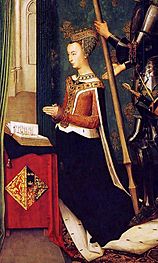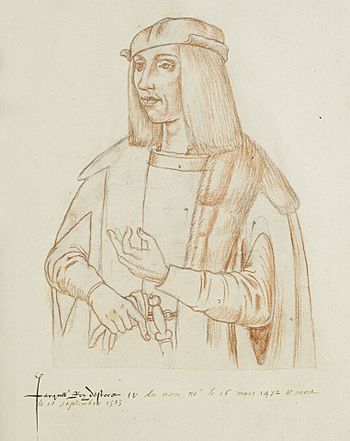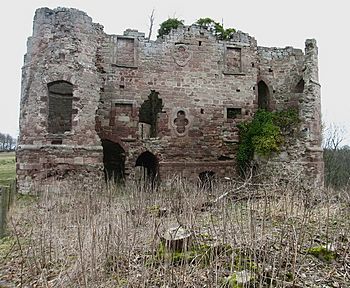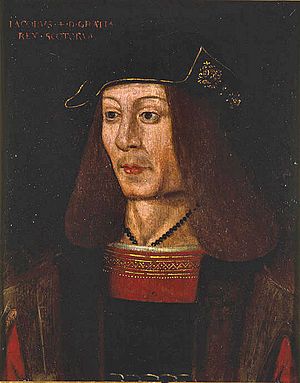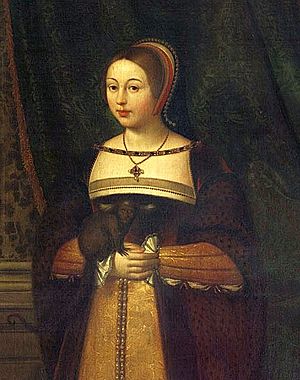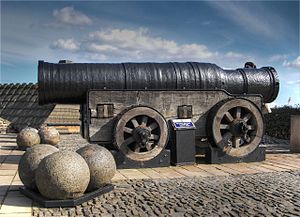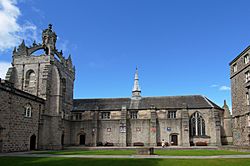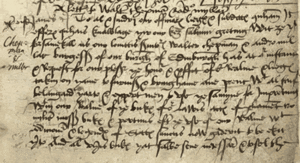James IV of Scotland facts for kids
Quick facts for kids James IV |
|
|---|---|

James IV, copy by Daniël Mijtens of a lost contemporary portrait
|
|
| King of Scotland | |
| Reign | 11 June 1488 – 9 September 1513 |
| Coronation | 24 June 1488 |
| Predecessor | James III |
| Successor | James V |
| Born | 17 March 1473 Stirling Castle, Stirling, Scotland |
| Died | 9 September 1513 (aged 40) Branxton, Northumberland, England |
| Spouse | |
| Issue more... |
|
| House | Stewart |
| Father | James III of Scotland |
| Mother | Margaret of Denmark |
| Religion | Roman Catholic |
James IV (born 17 March 1473 – died 9 September 1513) was the King of Scotland. He ruled from 11 June 1488 until he died in battle in 1513. He became king at just fifteen years old. This happened after his father, James III, died during a rebellion. Young James was seen as the leader of the rebels.
Many people think James IV was the most successful king from the Stewart family. He greatly expanded Scotland's navy. He built two royal shipyards and acquired or built 38 ships. One of these was the Michael, which was the largest warship of its time.
James loved the arts and was interested in law, literature, and science. He even tried out dentistry and bloodletting himself. During his reign, the first printing press came to Scotland. The Royal College of Surgeons of Edinburgh and the University of Aberdeen were also founded. He ordered the building of Holyroodhouse and Falkland Palace. He also did a lot of building work at Linlithgow Palace, Edinburgh Castle, and Stirling Castle. A law passed in 1496 made schooling compulsory for some children.
During James's 25 years as king, the royal income doubled. The king also gained strong control over the Scottish church. Royal power reached the Highlands and the Hebrides. By 1493, James had defeated the last independent Lord of the Isles. Relations with England improved with the Treaty of Perpetual Peace in 1502. This was followed by James's marriage to Margaret Tudor in 1503. This marriage later led to the Union of the Crowns in 1603. This happened when Elizabeth I of England died without children. James IV's great-grandson, James VI, then became King of England.
After 1497, Scotland had a long period of peace at home. This allowed James to focus on foreign policy. He sent warships to help his uncle, King John of Denmark, against Sweden. He also had good relationships with the Pope, Holy Roman Emperor Maximilian I, and Louis XII of France. James even hoped to lead a European naval crusade against the Turks. In 1507, Pope Julius II gave James the title Protector and Defender of the Christian Faith.
In 1513, Henry VIII of England invaded France. James chose to support France, due to the Auld Alliance. He led a large army into England. James and many of his nobles died at the Battle of Flodden on 9 September 1513. He was the last king in Great Britain to die in battle. His son, James V, became king after him.
Contents
- Growing Up: James IV's Early Life
- Becoming King: James IV's Early Reign
- Peace with England and Royal Marriage
- How James IV Ruled Scotland
- Culture, Learning, and Royal Buildings
- People from Africa at the Scottish Court
- Diplomacy and War with England
- The Battle of Flodden
- The King's Death and Legacy
- Children of James IV
- James IV in Stories and Media
- Images for kids
- See also
Growing Up: James IV's Early Life
James was born on 17 March 1473 at Stirling Castle. He was the oldest son of King James III and Margaret of Denmark. As the heir apparent to the Scottish throne, he became Duke of Rothesay when he was born. James likely spent most of his childhood at Stirling Castle. He was cared for by his mother, along with his two younger brothers.
In 1478, Queen Margaret was officially put in charge of James's education. We don't know much about his early life. But we do know he received a good education. His teachers included Archibald Whitelaw, the Secretary of State. James learned to speak Latin and Spanish very well. He also knew French, German, Flemish, and Italian. He was the last Scottish king known to speak Gaelic.
In 1474, James III agreed to a peace treaty with Edward IV of England. This treaty planned for Prince James to marry Edward's daughter, Cecily of York. This was part of James III's plan to be friends with England. Many people in Scotland did not like this idea.

James III was not a popular king. He faced two big rebellions during his rule. He also had problems with his own family. His policy of being friendly with England caused trouble. In 1480, peace with England broke down. This led to an English invasion of Scotland in 1482.
When James III tried to lead his army, his soldiers rebelled. He was even put in prison for a short time. During this time, James's uncle, the Duke of Albany, visited the young Prince James. They talked about the problems facing the country.
For nine-year-old James, the events of 1482 changed his calm life. After his mother died in 1486, James III seemed to favor his second son. This made Prince James worried.
On 2 February 1488, Prince James left Stirling Castle without his father knowing. This started another major rebellion against James III. The rebels were led by powerful earls and families. The prince became the symbol of the rebels. They said they took him from Stirling to protect him from his father. Many rebels also feared for their safety if James III kept ruling.
The conflict came to a head on 11 June 1488. The royal army and the rebel army fought at the Battle of Sauchieburn. The royal army was defeated, and James III was killed. Some stories say Prince James had forbidden anyone to harm his father. James IV felt very guilty about his indirect role in his father's death. He decided to do penance for this. He wore an iron belt around his waist, next to his skin. He added more weight to it every year for the rest of his life.
Becoming King: James IV's Early Reign
The rebels quickly took control after their victory. On 12 June, just one day after the battle, the new king issued his first order. Edinburgh and Stirling castles were secured. The late king's money and jewels were also taken. The rebel leaders were rewarded with important government jobs.
James IV's coronation took place on 24 June 1488 at Scone Abbey. The new king was crowned by Robert Blackadder, the Bishop of Glasgow. A few days later, James IV attended his father's burial. This scene was later shown in James IV's book of hours. The new king also hosted his great-uncle, Gerhard VI, Count of Oldenburg, from Denmark.
James IV quickly showed he was a wise and effective ruler. He put Patrick Hepburn, 1st Earl of Bothwell, Archibald Douglas, 5th Earl of Angus, and William Elphinstone, Bishop of Aberdeen in charge of his government. In 1489, he defeated a major rebellion. He laid siege to several castles and won a battle at Gartloaning.
James also took a direct interest in justice. He ended a long-standing feud between two clans. He also traveled around the kingdom to hold justice ayres, which were special court sessions. Parliament approved a tax of £5,000 to find a foreign bride for the king. Pope Innocent VIII gave James the Golden Rose in 1491. The alliance with France was renewed. Treaties were made with Denmark and Spain. Truces were also agreed with Henry VII of England in 1493 and 1494. In 1494, James received the Sceptre of Scotland as a gift from Pope Alexander VI.
James IV met with Hugh Roe O'Donnell, the King of Tyrconnell, in June 1495. O'Donnell was a powerful Irish leader who opposed Henry VII. The Scottish and Irish kings made a defensive alliance. They also talked about Perkin Warbeck, who claimed to be the rightful King of England.
James IV welcomed Warbeck to Scotland in November 1495. James was interested in Warbeck because other European leaders supported his claim. This gave James IV a way to gain power in Europe. By threatening Henry VII with Warbeck, James hoped to get a better alliance offer from England. Spanish ambassadors arrived in Edinburgh to help with the situation.
In September 1496, James IV invaded England with Warbeck. They destroyed several towers and castles. However, the army quickly retreated when supplies ran out. The hoped-for support for Perkin Warbeck in Northumberland did not happen. The Scottish army left on 25 September 1496 when an English army approached.
Later, James IV wanted to get rid of Warbeck. He provided a ship and crew for Warbeck to sail to Ireland in July 1497. In August 1497, James invaded England again. He laid siege to Norham Castle with a large artillery force, including Mons Meg.
Peace with England and Royal Marriage
James IV used war to push his diplomatic goals with England. Henry VII realized how vulnerable the border was. So, Henry decided to seek peace with James. The Treaty of Ayton was signed on 30 September 1497. This agreement set a seven-year truce between Scotland and England. It also allowed for trade and shipping.
The treaty also suggested strengthening the peace. This would happen through the marriage of James IV to Henry VII's oldest daughter, Margaret Tudor.
After several years of peace, Scottish and English officials met in 1502. They agreed on the marriage between James IV and Margaret. Margaret would bring a dowry of £35,000 Scots. They also signed the Treaty of Perpetual Peace. This treaty promised "good, real and sincere, true, sound, and firm peace, friendship, league and confederation, to last all time coming" between England and Scotland. Neither king was to make war against the other. If either king broke the treaty, the Pope would excommunicate them.
On 10 December 1502, James confirmed the treaty in Glasgow Cathedral. This was the first peace treaty between Scotland and England since 1328. The marriage was completed by proxy on 25 January 1503. Margaret left England for Scotland on 27 June. She was welcomed at the border on 1 August 1503.
On 8 August 1503, the marriage was celebrated in person at Holyrood Abbey. The 30-year-old Scottish king married his 13-year-old English bride. Their wedding was remembered in a special book of hours. The poet William Dunbar wrote about it as the marriage of the thistle and the rose. These are the flowers of Scotland and England.
It's possible that the marriage was not fully completed right away. This was common when young brides married in medieval times. Margaret did not have her first child until she was 17. This suggests James IV respected this custom.
James IV's marriage to Margaret was very important. It meant that if Henry VIII had no children, James or his descendants could become King of England. Margaret's first child, James, Duke of Rothesay, was born in February 1507. But he died a year later. She had another child, a daughter, who was born and died in July 1508. In October 1509, a second son, Arthur, was born. His name reminded Henry VIII that a son of Margaret Tudor might become king if Henry had no male heir.
How James IV Ruled Scotland
Controlling the Highlands and Isles

In 1476, John of Islay, the Lord of the Isles, lost his lands to James III. This was because of a secret treaty he made with England. After this, the MacDonald islanders often invaded Ross-shire. In 1491, Alexander MacDonald tried to get back the Earldom of Ross. He raided Ross-shire with other clans. They stormed Inverness Castle.
Because of this uprising, Parliament declared John MacDonald's lands and title forfeited to the Crown in 1493. In August 1493, King James made his first trip to the western Highlands. He sailed to Dunstaffnage Castle. There, local chiefs promised their loyalty to him. John of Islay surrendered and was given a yearly payment.
The next year, Sir John MacDonald rebelled. In July, the king sailed with an army to Tarbert Castle. The royal forces repaired castles. Sir John was later captured and executed for treason. In 1495, King James went on his third and final trip to the Isles. He rewarded chiefs who supported the Crown.
In October 1496, the Privy Council said clan chiefs would be responsible for crimes in the region. This law was hard to enforce. After a law in 1498 questioned the chiefs' land titles, resistance grew. James waited at Kilkerran Castle in 1498 to re-grant the chiefs' land charters. Few chiefs showed up.
Archibald Campbell, 2nd Earl of Argyll, tried to enforce royal authority. But he had limited success. In 1501, Torquil MacLeod was ordered to hand over Domhnall Dubh, the heir to the Lordship of the Isles. James waited, but Torquil never came.
After this defiance, Alexander Gordon, 3rd Earl of Huntly, was given Torquil's lands. He raised an army and replaced tenants with his supporters. In 1504, a royal fleet sailed north to attack Castle of Cairn-na-Burgh. This was where Domhnall Dubh was thought to be held. The castle was captured by June 1504, but Domhnall Dubh remained free. In September 1507, Torquil MacLeod was besieged at Stornoway Castle. Domhnall Dubh was captured and imprisoned for 37 years. Torquil MacLeod died in exile in 1511. The Earl of Huntly was well rewarded for his efforts.
Parliament and Royal Money
James IV's reign saw fewer parliaments being held. In his first eight years, ten meetings were held. But in the next seventeen years, there were only three. The number of people attending also went down. This was similar to other European monarchies at the time. Kings relied more on their councils than on large assemblies.
After the conflicts with England ended in 1497, the king didn't need Parliament to raise taxes as often. Perhaps James IV thought frequent parliaments caused problems for royal rule. He found other ways to get money. He also didn't want to call meetings that might disagree with him. The last three parliaments of his reign were called to deal with justice and rebels. James IV managed to rule well without regular parliaments. He used general councils and larger meetings of the Privy Council.

From the start of his reign, James wanted to increase the Crown's income. He needed money to pay for all government expenses. This money came from Crown lands, towns, and taxes. The yearly income from these sources stayed around £5-6,000 Scots. However, much of the town income was given away to nobles and servants.
Parliament could grant the king more money through taxes. Between 1488 and 1497, Parliament voted for taxes almost every year. This money paid for diplomacy, naval trips, and wars with England. But James soon learned that heavy taxes could cause resistance. After failing to raise a huge sum in 1502-04, no more taxes were imposed until 1512. Even then, the tax was only on the clergy.
James's yearly income grew a lot between 1497 and 1513. In 1497, he received a large sum when Archbishop William Scheves died. James appointed his younger brother, the Duke of Ross, as archbishop. This brought the highest church office into the royal family. It also gave the Crown about £2,500 a year. This was a smart move by the king. It removed any potential threat from his younger brother. James also appointed Ross to other important church roles.
In 1498, James IV turned twenty-five. He could then formally cancel any grants he made during his youth. This was to show royal authority and raise money. People who held lands and offices had to pay to confirm their holdings. Margaret Tudor's dowry also brought in £10,000 sterling. By the end of his reign, the Treasurer's yearly income had increased greatly. It went from about £4,500 in 1496-97 to £28,000 by 1512. When other incomes are added, James IV might have received about £44,500 by 1513.
Building a Strong Military
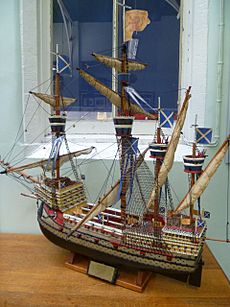
James IV was very interested in developing the Royal Scots Navy. He saw a strong fleet as a way to protect Scottish ships. It also gave him international respect. And it allowed him to pursue foreign policies. During his reign, James ordered or bought at least 38 ships. His naval building program was very large for a small kingdom. Spending on the navy was the biggest part of royal expenses in his later years. In the early years, he spent about £140 Scots annually. By the early 1510s, it was £8,710 10/-.
In 1491, James decided to stop attacks on Scottish ships. These attacks came from English and other pirates in the Firth of Forth. He built forts at Largo and Inchgarvie. He also repaired Dunbar Castle to defend the area. James also complained to King Manuel I of Portugal about Portuguese piracy. He gave letters of marque to Andrew Barton. This allowed Barton to attack Portuguese ships.
After the Lordship of the Isles was forfeited in 1493, James led naval expeditions. These went to Argyll and the Hebrides between 1492 and 1498. In May 1502, James sent a fleet of five ships and 2,000 soldiers to Denmark. This was to help his uncle, John, King of Denmark, against an uprising. This Danish trip made James IV focus more on expanding his navy. Shipbuilders and craftsmen were hired from Scotland and other countries. Timber for ships came from Scotland, Norway, and France. James also founded new dockyards at Newhaven in 1504 and Pool of Airth in 1506. The king even wore the symbols of an Admiral – a whistle and a gold chain.
The Margaret, launched in 1506, weighed about 600-700 tons. It had many guns and cost about £8,000. This was more than a quarter of his yearly income. The carrack Great Michael was the largest warship of its time. It was built at Newhaven and launched in 1511. It was very long and weighed about 1,000 tons. It was said to have cost about £30,000. It had twenty-four bronze cannons. This ship was designed to carry heavy artillery. The navy's main ships were supported by smaller boats and private merchant ships.
James IV was also very interested in artillery from early in his reign. In 1507, he shot 'great guns' at Holyrood Abbey. The next year, he held shooting matches with hand culverins. He even used a culverin to hunt deer. James IV imported guns, shot, and powder from France. In 1511, the royal gun foundry moved to Edinburgh Castle. Scottish, Dutch, and French gunmakers worked there. They made guns for the Michael and the Seven Sisters. These were cannons later captured by the English at Flodden.
Culture, Learning, and Royal Buildings
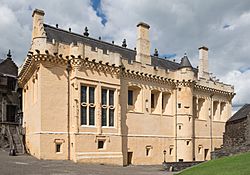
James IV was a true Renaissance prince. He supported many artists and writers, especially Scottish poets. Poets like William Dunbar were part of his court. James also supported music. He helped found King's College, Aberdeen, and St Leonard's College, St Andrews. In 1496, he passed what is called Scotland's first education act. This law made schooling compulsory for the oldest sons of all important landowners.
James was very intelligent and well-educated. He made sure his illegitimate son, Alexander, got the best education. Alexander was tutored by Erasmus in Italy. James IV reportedly did an experiment. He sent two children to be raised by a woman who couldn't speak on an island. He wanted to see if language was learned or natural.
James IV had many interests. He was interested in practical and scientific things. He supported the creation of Scotland's first printing press, Chepman and Myllar Press, in 1507. He also gave a royal charter to the Royal College of Surgeons of Edinburgh in 1506. James was interested in dentistry. In 1503, he had a barber-surgeon pull one of his teeth. In 1504, he bought tools to pull teeth himself. He even pulled two teeth from one of his own barber-surgeons. He also tried bloodletting and treating wounds.
He was also interested in alchemy. He set up a workshop at Stirling Castle. There, an alchemist named John Damian tried to turn metals into gold. This project used a lot of expensive materials. Damian also researched flying. He tried to fly from Stirling Castle, but it failed. The poet William Dunbar made fun of this in his poems.
James spent a lot of money building or improving royal homes. He ordered the building of Holyroodhouse between 1501 and 1505. This was next to Holyrood Abbey. The work likely started because of his marriage to Margaret Tudor. Their wedding took place in the abbey in August 1503 while building was still going on. James also ordered the building of Falkland Palace in Fife between 1501 and 1513.
At Stirling Castle, James rebuilt the chapel royal. He also built a new royal lodging and improved the castle's defenses. He remodeled Linlithgow Palace and built the great hall at Edinburgh Castle. He furnished his palaces with beautiful tapestries.
The first record of whisky being made in Scotland is from 1494. It mentions malt being sent to "Friar John Cor... to make aquavitae" (whisky). This was enough to make about 500 bottles. James IV reportedly loved whisky. In 1506, the town of Dundee bought a lot of whisky. It came from the Guild of Barber-Surgeons, who had the right to produce it then.
People from Africa at the Scottish Court
James IV's court was very diverse. It included people from many countries, like French and Italian musicians. The court also had several people from Africa. Some worked as servants. Others seemed to be courtiers, guests, or musicians.
In 1504, two African women are mentioned in royal records. They were later named Margaret and Helen or Elen More. These women were visible in court life. Helen More is believed to be the subject of a poem by William Dunbar. The poem describes an African woman offered as a prize in jousting tournaments.
An African drummer, called the "More taubronar", traveled with James. "Peter the Moor" was an African man whose travels were paid for by the king. He first appears in records in 1500. Some historians think he and other Africans came to Scotland after being captured from Portuguese ships. Records show Peter the Moor was a companion to King James on his trips. He appears in records until August 1504. Historian Imtiaz Habib believes Peter was a "favourite companion to the monarch" and was "well accepted" at court.
The status of Africans at James IV's court is debated. Some historians think the two women, Elen and Margaret More, were in a "benevolent form of... black slavery." Other historians say these people were treated as "court curiosities." They likely had little control over their own lives and were probably enslaved to some extent.
Diplomacy and War with England
In 1507, Pope Julius II gave James the title Protector and Defender of the Christian Faith. In April 1507, James received the Blessed sword and hat. In 1508, James IV planned to go on a pilgrimage to Jerusalem. His uncle, King John of Denmark, warned him against it. He said James should think of his young wife and country first.
Archbishop Blackadder left Scotland in February 1508 for a pilgrimage to the Holy Land. This was probably to check things out for the king. Blackadder died in July, likely from illness. This seemed to convince James IV not to sail to Jerusalem. In 1507-8, Louis XII of France wanted James to renew the alliance between France and Scotland. James wrote to Louis about a joint crusade to the Holy Land.
James's good relations with France sometimes caused problems with England. In April 1508, Thomas Wolsey was sent to Scotland. He wanted to discuss Henry VII's worries about James renewing the Auld Alliance with France. Wolsey found he was "never a man worse welcome into Scotland than I." He couldn't persuade James to abandon the Auld Alliance. But relations between England and Scotland stayed stable until Henry VII died in 1509.
Relations between Scotland and England worsened when Henry VIII of England became king in April 1509. Unlike his father, Henry was not interested in pleasing James. Henry VIII also believed the King of Scots owed him obedience. A main reason for the growing hostility was James IV's position regarding the English throne. From 1509 until his daughter Mary was born in 1516, Henry had no recognized heir. Through his wife Margaret, James IV was an heir to the English throne. When Margaret had a son in October 1509, he was named Arthur. This name was chosen to highlight the Scottish claim to the Arthurian legend. It was also a British name for a potential British king. Then, in April 1512, Margaret had another boy, named James. This boy, the future James V, was still alive a year later. His uncle, Henry VIII, still had no children.
In October 1511, Pope Julius II created a Holy League against France. This alliance included the Papacy, Venice, Spain, and the Holy Roman Empire. In November 1511, England joined the League. Henry VIII decided to use this as an excuse to make a treaty with Spain against France.
Relations between the Scottish and English kings continued to get worse. In 1512, the English parliament passed a law. This law stated that the King of Scots owed "homage and obedience" to Henry VIII. This was an attack on Scotland's independence. The English said James IV had broken the peace. But James had not even agreed to renew the alliance with France yet. The Pope was supposed to settle such disputes. But Pope Julius II was now an ally of England.
James IV had refused France's requests to renew their alliance. Louis XII was not offering enough in return. However, Henry VIII's aggressive actions pushed James to renew the Auld Alliance. James formally agreed to the alliance in July 1512. But this was more of a gesture than a promise of active support. It was still possible Scotland would stay neutral.
Before he died in February 1513, Pope Julius II was persuaded to punish the Scottish people. He also threatened to excommunicate the Scottish king if he broke the treaty with England. James IV sent Andrew Forman, the Bishop of Moray, to Rome. He tried to persuade the new Pope, Leo X, to stop the punishment. But he failed. Leo sent a letter to James, threatening him. In the summer of 1513, James IV was excommunicated.
On 30 June, Henry VIII invaded France. His troops defeated a French army. James IV gathered the Scottish army. He sent a naval fleet of twenty-two ships, including the Great Michael, to join France's ships. The fleet left on 25 July. It first attacked the English garrison in Carrickfergus, Ireland. The Scottish fleet then joined the French fleet at Brest. This was meant to cut off the English army's supplies. However, the fleet was so delayed that it didn't play a part in the war. Unfortunately, James had sent most of his experienced artillerymen with this expedition. This decision had big consequences for his land campaign.
The Battle of Flodden
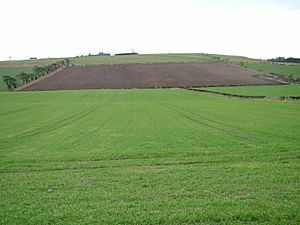
Led by James IV, the Scottish army crossed the River Tweed into England around 22 August. The army had about 42,000 men and many cannons. Scottish soldiers were only required to serve for forty days. Once across the border, some soldiers attacked Wark on Tweed Castle. The main army moved south, capturing Norham Castle, Etal, and Ford.
On 8 September, the Scottish army took a position on Branxton Hill in Northumberland. They faced an English army led by Thomas Howard, Earl of Surrey. James's army was smaller now due to sickness and desertion. But it still had about 34,000 men, outnumbering the English by 8,000. The Scottish infantry had long pikes from their French allies. These were new weapons that needed training and good ground to work well. The Scottish artillery had heavy siege guns. The English infantry used traditional pole weapons, mostly bills. They also had many skilled archers with English longbows. The English artillery had lighter, older cannons that fired quickly.
James IV started the battle with an artillery duel. But his heavy guns didn't work well. This was because it was hard for the Scots to shoot downhill. Also, their guns were set up too quickly. This allowed the light English guns to fire rapidly at the Scottish infantry. The Scottish left wing, led by Lord Home and the Earl of Huntly, advanced downhill. Their heavily armored men were in the front. The English archers had little effect. The English formation was pushed back. But then English horsemen intervened. The result was a stalemate, and both sides stopped fighting.
Meanwhile, James saw the initial success of Home and Huntly. He ordered the next group of soldiers to advance. They were led by the Earls of Errol, Crawford, and Montrose. At the bottom of Branxton Hill, they faced an unexpected problem: marshy ground. Days of heavy rain made it worse. As they struggled to cross, the Scots lost their formation. Their long pikes became difficult to use. They dropped their pikes and used swords and axes. But the English bills were longer in close combat.
It's unclear if James saw the difficulties. But he followed down the slope anyway, heading for Surrey's formation. James has been criticized for fighting on the front line. This put him in danger and made him lose sight of the battle. However, he was known for taking risks. James's men fought their way to Surrey's bodyguards. Fierce fighting continued between Surrey and James. As other English groups defeated Scottish forces, they moved to help the Earl of Surrey. English troops were told not to take prisoners. This explains why so many Scottish nobles died. James IV himself was killed in the final part of the battle. He fought to within a spear's length of the Earl of Surrey.
The Battle of Flodden was one of Scotland's worst military defeats. Losing a popular king and many political leaders was a huge blow. James IV's son, James V, was crowned three weeks after the disaster. But he was only one year old. His time as a child king was full of political problems.
The King's Death and Legacy
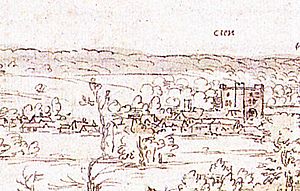
James IV's body was found the next day. It was surrounded by his archer bodyguards. Thomas Dacre, 2nd Baron Dacre identified the king. An arrow had pierced James's lower jaw. This injury would have made him unable to fight. English soldiers then attacked him with their bills. They almost cut off his left hand and sliced his throat.
James's body was taken to Berwick-upon-Tweed. It was embalmed and sealed in a lead coffin. Then it was sent to Sheen Priory in Surrey, England. It remained unburied there. James's torn and bloody surcoat was sent to Henry VIII.
Because James had been excommunicated, he could not be buried in holy ground. This was unless the Pope lifted the sentence. Henry VIII got permission from Pope Leo X in November 1513. This allowed the Scottish king to be buried in St Paul's Cathedral in London. But James IV remained unburied. His coffin stayed above ground at Sheen Priory. Decades passed, and the priory was closed in 1539 during the English Reformation.
During the reign of Edward VI of England, an old writer named John Stow saw the coffin. It was in a storage room "amongst old timber, stone, lead, and other rubble." James IV's coffin was found again during the reign of Elizabeth I of England. It was opened, and his body was treated badly. John Stow wrote that "Workmen there for their foolish pleasure hewed off his head." The body disappeared. Its last known resting place is now under a golf course. Elizabeth I's master glazier, Lancelot Young, is said to have kept James's head as a curiosity. He later asked the sexton of a local church to bury it.
Rumors spread that James IV had survived. Some said he was seen riding back across the Tweed. Others said he went on a pilgrimage to Jerusalem. Or that his body was buried in Scotland. Two castles in the Borders claim to be his resting place. One legend says that during the battle, four horsemen took the King's body. Another story says the king left the field alive but was killed soon after.
In the 19th century, a skeleton with a chain around its waist was found at Hume Castle. But this skeleton has since disappeared. Another version of this story says the skeleton was found a few years after the battle and reburied at Holyrood Abbey. The same story is told for Roxburgh Castle. Yet another tradition says the royal body was found at Berry Moss, near Kelso. These legends were fueled by writers like Robert Lindsay of Pitscottie. He claimed a criminal offered to show John Stewart, 2nd Duke of Albany the king's grave ten years after the battle. But Albany refused.
Children of James IV
Legitimate Children
| Name | Birth | Death | Notes |
|---|---|---|---|
| By Margaret Tudor | |||
| James, Duke of Rothesay | 21 February 1507 | 27 February 1508 | |
| Unnamed daughter | 15 July 1508 | Stillborn at Palace of Holyroodhouse | |
| Arthur, Duke of Rothesay | 20 October 1509 | 14 July 1510 | |
| James V | 10 April 1512 | 14 December 1542 | Married:
|
| Unnamed daughter | November 1512 | Stillborn at Palace of Holyroodhouse | |
| Alexander, Duke of Ross | 30 April 1514 | 18 December 1515 | |
James IV in Stories and Media
James IV has appeared in many historical novels, short stories, and other media. Here are some examples:
- The Yellow Frigate (1855) by James Grant. This novel covers the events of 1488, including the Battle of Sauchieburn and James IV becoming king. James IV and Margaret Drummond are important characters.
- In the King's Favour (1899) by J. E. Preston Muddock. This story covers the last few months of James IV's reign and ends with the Battle of Flodden.
- The Arrow of the North (1906) by R. H. Forster. This novel is mostly about Northumberland. It covers the Flodden campaign and ends with the battle where James IV died.
- The Crimson Field (1916) by Halliwell Sutcliffe. This book also covers the Anglo-Scottish Wars. It features James IV and gives a full account of the Battle of Flodden.
- King Heart (1926) by Carola Oman. This story is set in Scotland during James IV's time. The king himself appears in a section about the Battle of Flodden.
- Gentle Eagle (1937) by Christine Orr. This book tells the story of the king's life.
- Sunset at Noon (1955) by Jane Oliver. This book also tells the story of the king's life.
- Chain of Destiny (1964) by Nigel Tranter. This book covers the king's life from the Battle of Sauchieburn to Flodden.
- Falcon (1972) by A.J. Stewart. This is an unusual book by an author who claimed to be the king's reincarnation.
- Three Sisters, Three Queens (2016) by Philippa Gregory. This book is told from the point of view of Margaret Tudor and features James a lot.
- The Spanish Princess (2020) by Philippa Gregory. James is played by actor Ray Stevenson in this adaptation.
- James IV - The Queen of the Flight (2022). This is a play by Rona Munro that focuses on the life of Ellen More at his court.
Images for kids
-
Stirling Castle, James IV's birthplace
-
Twizell Castle on the River Till in Northumberland
-
Portrait of James's queen, Margaret Tudor
-
Tarbert Castle, visited by James IV in 1494
-
Gold unicorn coins from James III and James IV's reigns
-
A model of the Michael
-
Mons Meg, a large cannon
-
The Great Hall of Stirling Castle
-
The western side of the battlefield of Flodden
-
Sheen Priory from the west, c. 1558–62
See also
 In Spanish: Jacobo IV de Escocia para niños
In Spanish: Jacobo IV de Escocia para niños



